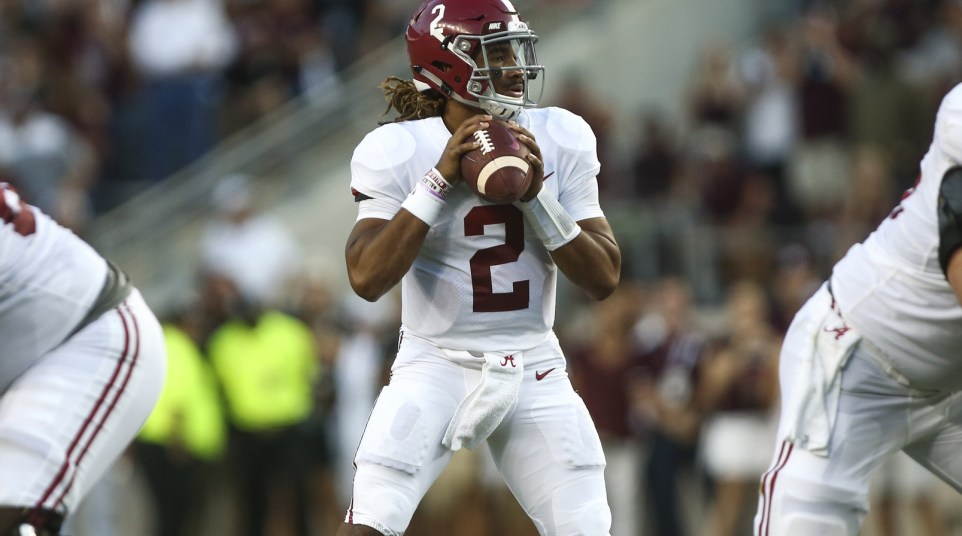
Why is everybody still criticizing Jalen Hurts?
Last season, Jalen Hurts became the first true freshman quarterback to start a football game for the University of Alabama since Vince Sutton in 1984.
The electric, running quarterback impressed in his first season at the Capstone, being named the SEC Offensive Player of the Year after throwing for 2,780 yards with 23 touchdowns while also adding 954 yards and 13 touchdowns on the ground.
As good as he was for a majority of the regular season, Hurts struggled in the postseason.
His production dipped in the passing game. His average passing yards per game were almost cut in half — going from 204.5 to 108.7 — and his completion percentage fell from 65.9 percent to 47.7 percent.
That poor stretch is where the critics really started to gain steam, and there were a lot of people who put Alabama’s loss to Clemson in the national championship game on Hurts’ shoulders. (Even though it was his 30-yard touchdown run that gave Alabama a lead with 2:07 left.)
The entire offseason saw analysts, fans and talking heads picking apart his game, stating that he needed to do a better job processing things mentally, keeping his eyes up when facing a pass rush and continuing to work through his progressions instead of running at the first sign of trouble.
The results coming out of Tuscaloosa were positive as fall camp approached, and Hurts was even able to earn the praise of Archie Manning at the Manning Passing Academy in June.
Then the season started, and the criticism quickly returned. Hurts didn’t put up the eye-popping statistics in the opening win against FSU, finishing with just 96 yards through the air.
He was facing one of the best defensive fronts in all of college football, however, and despite the minimal production statistically, Hurts actually performed pretty well if you dive into the film.
Hurts was even named to Pro Football Focus’s SEC Team of the Week for his performance, but that didn’t silence the critics.
PFF Week 1 SEC Team of the Week – Offense pic.twitter.com/Xdkez9K8ka
— PFF College Football (@PFF_College) September 5, 2017
There was the normal noise: his inability to complete passes vertically, not properly working through his progressions and taking off too soon.
Those are warranted criticisms, at least to some degree, because they are still his biggest weaknesses, but there has been improvement.
The first thing is the inability to complete passes vertically. The numbers have not been favorable, but they don’t tell the entire story. Consider the past two SEC games against Ole Miss and Texas A&M.
Hurts went 0-of-6 on passes traveling 20 yards or more. That seems like it would terrible, but look at what they actually were.
— Clint Lamb (@ClintRLamb) October 10, 2017
Here’s a breakdown of each deep ball attempt against Ole Miss (above):
- 0-for-1 (poorly thrown ball)
- 0-for-2 (DB carried Foster out of bounds)
- 0-for-3 (dropped pass in the end zone by Henry Ruggs)
It should also be noted that Hurts completed several throws between 15 to 19 yards.
— Clint Lamb (@ClintRLamb) October 10, 2017
Here’s the breakdown of each deep ball attempt against Texas A&M (above):
- 0-for-1 (not a bad throw, but a hair too fair outside)
- 0-for-2 (CB illegally grabbed Smith to slow him down and ball went off Smith’s fingertips)
- 0-for-3 (also not a terrible throw)
Now, the last play on that clip is a pass interference call in the end zone that should’ve been completed. It was a perfectly thrown ball that didn’t work out in Hurts’ favor. That isn’t the first time a deep pass wasn’t completed by no fault of Hurts, however.
Here are several attempts that didn’t count toward his statistics due to drops or penalties, neither of which were Hurts’ fault.
— Clint Lamb (@ClintRLamb) October 10, 2017
This just in: Numbers occasionally lie.
The second thing is Hurts not working through his progressions. This is a legitimate criticism as Hurts doesn’t do this with any consistency. His legs essentially act as his second read, and while that can be extremely effective — Hurts has produced over 500 rushing yards and 5 touchdowns already this season — it can also cripple him as a passer.
Hurts has shown glimpses of being able to work from his first to second read at times, though.
— Clint Lamb (@ClintRLamb) October 10, 2017
It’s only a small improvement, but it does show that he only needs to work on adding consistency in that area.
The last thing Hurts is constantly criticized for is looking to run every time he escapes the pocket. While that is definitely still an issue, Hurts has shown noticeable improvement in this area as well.
Here are several examples of Hurts still maintaining that “pass-first” mindset when escaping the pocket.
— Clint Lamb (@ClintRLamb) October 10, 2017
Overall, Hurts is not a finished product. He clearly has a lot more room for growth, but the point should be that he is making small strides in the right direction.
He’s doing that without turning the ball over and putting up significant numbers as a runner. That’s why coach Nick Saban doesn’t see any need to make the change to the true freshman Tua Tagovailoa.
While the criticisms of Hurts aren’t necessarily wrong, there aren’t enough people willing to admit that he is improving — and still winning.
Consistency is key, and hopefully, that will come with time.
MORE TIDE: No rat poison here. 10 worst things we can say about Bama
